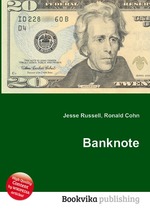Banknote
Jesse Russell Ronald Cohn
бумажная книга
High Quality Content by WIKIPEDIA articles! A banknote (often known as a bill, paper money or simply a note) is a type of negotiable instrument known as a promissory note, made by a bank, payable to the bearer on demand. When banknotes were first introduced, they were, in effect, a promise to pay the bearer in coins, but gradually became a substitute for the coins and a form of money in their own right. Banknotes were originally issued by commercial banks, but since their general acceptance as a form of money, most countries have assigned the responsibility for issuing national banknotes to a central bank. National banknotes are legal tender, meaning that medium of payment allowed by law or recognized by a legal system to be valid for meeting a financial obligation. Historically, banks sought to ensure that they could always pay customers in coins when they presented banknotes for payment. This practice of "backing" notes with something of substance is the basis for the history of central banks backing their currencies in gold or silver. Today, most national currencies have no backing in precious metals or commodities and have value only by fiat. With the exception of non-circulating high-value or precious metal issues, coins are used for lower valued monetary units, while banknotes are used for higher values.


